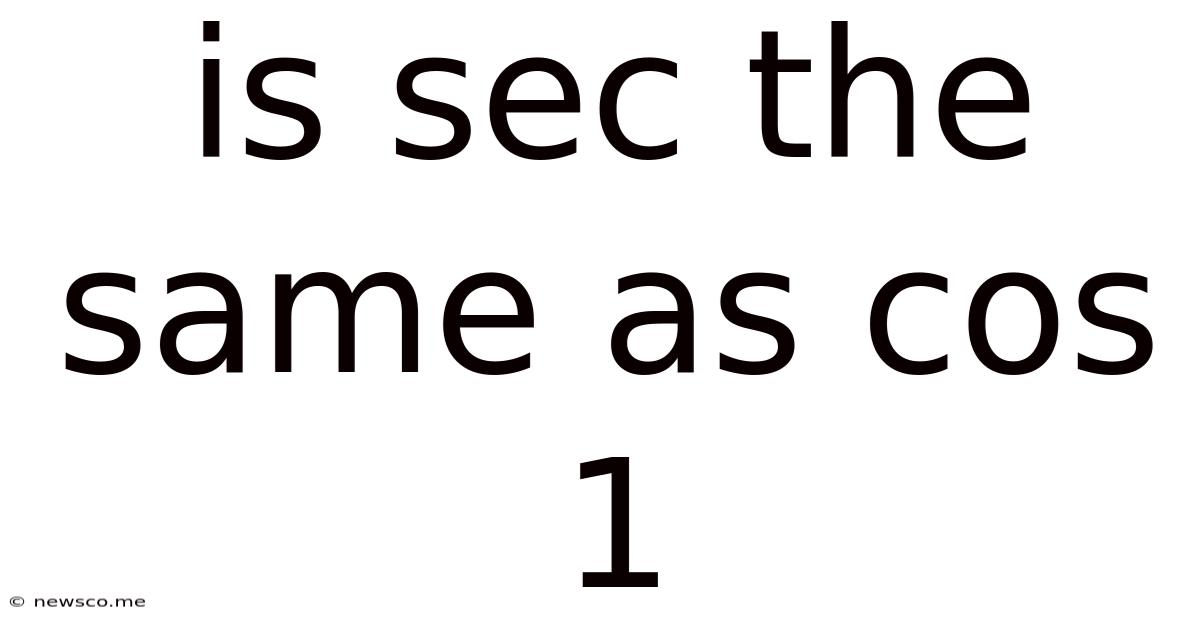Is Sec The Same As Cos 1
News Co
May 08, 2025 · 5 min read

Table of Contents
Is Sec the Same as Cos⁻¹? Unraveling the Trigonometric Relationship
The question, "Is sec the same as cos⁻¹?" is a common point of confusion for students beginning their journey into trigonometry. While both sec (secant) and cos⁻¹ (inverse cosine) relate to the cosine function, they are fundamentally different mathematical operations. Understanding their distinctions is crucial for accurate trigonometric calculations and problem-solving. This article will delve into the definitions, properties, and applications of both secant and inverse cosine, clarifying their differences and highlighting where misconceptions might arise.
Understanding the Secant Function (sec)
The secant function, denoted as sec(x), is one of the six fundamental trigonometric functions. It's defined as the reciprocal of the cosine function:
sec(x) = 1 / cos(x)
This means that the secant of an angle is equal to the inverse of the cosine of that angle. The secant function, like cosine, is defined for all angles except those where the cosine is zero (i.e., odd multiples of π/2). Its graph displays asymptotes at these points, reflecting its undefined nature at these specific angular values. The range of the secant function is (-∞, -1] ∪ [1, ∞), indicating that its values are always less than or equal to -1 or greater than or equal to 1.
Key Properties of the Secant Function:
- Reciprocal Identity: As mentioned, the defining characteristic is its reciprocal relationship with cosine:
sec(x) = 1 / cos(x). - Periodicity: The secant function is periodic with a period of 2π, meaning
sec(x + 2π) = sec(x). - Even Function: The secant function is an even function, meaning
sec(-x) = sec(x). This symmetry is reflected in its graph. - Derivatives and Integrals: The derivative and integral of the secant function are more complex than those of cosine and involve natural logarithms. These are often encountered in calculus.
- Applications: The secant function finds applications in various fields, including physics (particularly in wave phenomena and mechanics) and engineering (for example, in calculations related to oscillations and vibrations).
Understanding the Inverse Cosine Function (cos⁻¹)
The inverse cosine function, denoted as cos⁻¹(x) or arccos(x), is the inverse function of the cosine function. It answers the question: "What angle has a cosine of x?" Unlike the secant function, which is a transformation of cosine, the inverse cosine is a fundamentally different operation.
cos⁻¹(x) = y if and only if cos(y) = x
This means the inverse cosine function returns an angle whose cosine is the given input value. The domain of the inverse cosine function is [-1, 1], reflecting the range of the cosine function. The range of the inverse cosine function is typically restricted to [0, π] to ensure a unique output for each input within the domain.
Key Properties of the Inverse Cosine Function:
- Inverse Relationship: The defining characteristic is its inverse relationship with the cosine function:
cos(cos⁻¹(x)) = xfor x in [-1, 1] andcos⁻¹(cos(x)) = xfor x in [0, π]. - Range Restriction: The range is restricted to [0, π] to ensure a single-valued function.
- Relationship with other trigonometric functions: The inverse cosine can be expressed using other inverse trigonometric functions, leading to useful identities in problem solving.
- Derivatives and Integrals: The derivative and integral of the inverse cosine function have specific forms that are valuable in calculus applications.
- Applications: The inverse cosine is extensively used in geometry, navigation, and various fields requiring the calculation of angles from known cosine values. It's essential in solving triangles and determining angular positions.
The Crucial Difference: Reciprocal vs. Inverse
The key distinction lies in the nature of the operations:
-
Secant (sec) is a reciprocal function. It takes the reciprocal of the cosine value. It's a transformation applied to the cosine function.
-
Inverse Cosine (cos⁻¹) is an inverse function. It finds the angle corresponding to a given cosine value. It's a separate operation that reverses the cosine function's mapping.
Example:
Let's consider the angle x = π/3.
- cos(π/3) = 0.5
- sec(π/3) = 1 / cos(π/3) = 1 / 0.5 = 2
- cos⁻¹(0.5) = π/3
As you can see, the secant of π/3 is 2, while the inverse cosine of 0.5 is π/3. They yield completely different results and represent different mathematical processes.
Common Misconceptions and How to Avoid Them
A frequent error is confusing sec(x) with cos⁻¹(x). This stems from a misunderstanding of the mathematical operations involved. Remembering that secant is a reciprocal and inverse cosine is an inverse is crucial for avoiding errors.
Another potential source of confusion is the notation. The notation cos⁻¹(x) might be misinterpreted as 1/cos(x), but it specifically denotes the inverse function, not the reciprocal. Using arccos(x) can help avoid this ambiguity.
Conclusion: Distinct Functions, Distinct Applications
In summary, while both secant and inverse cosine are related to the cosine function, they are distinct mathematical entities with different meanings and applications. Secant is a reciprocal function that transforms the cosine value, while inverse cosine is an inverse function that finds the corresponding angle. Understanding their differences is fundamental for mastering trigonometry and effectively solving problems in various scientific and engineering disciplines. By clarifying these concepts and avoiding common misconceptions, you'll build a stronger foundation in trigonometry and enhance your problem-solving capabilities. This understanding is not only critical for academic success but also for practical applications in fields requiring trigonometric calculations. The careful distinction between reciprocal and inverse functions is key to accurate and efficient mathematical work.
Latest Posts
Related Post
Thank you for visiting our website which covers about Is Sec The Same As Cos 1 . We hope the information provided has been useful to you. Feel free to contact us if you have any questions or need further assistance. See you next time and don't miss to bookmark.